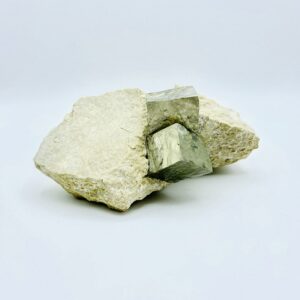-Pyrite or Fool’s Gold, however you may call it, is quite a popular mineral amongst rock collectors and even hobbyists. It is one of the most abundant minerals in the world, meaning that you are almost guaranteed to have some pyrite near you. If you’re not already aware of this, then we suggest that you get used to it because pyrite is going to be around us for a very long time. In this article we will share information about where you can find beautiful specimens and how to tell which ones are real from fake. We will also discuss the different types of fool’s gold (its crystal habit, cleavage and color), how to identify it and possible uses if it ends up being authentic.
 Photo credits: Assignment_Houston_One
Photo credits: Assignment_Houston_One
Pyrite crystals for the mineral collector
Pyrite crystals are amongst the most popular collecting targets in the world. They are abundant, cheap and relatively easy to find in places like the United States and Australia. So, if you are looking for a good mineral to collect, you should definitely consider pyrite. Pyrite is an iron sulfide mineral with cubic crystals that usually have sharp angles. It’s hardness is 2.5 on Mohs scale or 5-6 on the old Vickers scale of hardness. The cleavage angle is about 110 degrees and it has a brittle luster that might be considered glassy by some collectors. As mentioned earlier, pyrite crystals come in many different habits and colors. The most prevalent crystal habit is tabular, meaning that they look like thin pyramids standing up from the ground or other minerals in the vicinity. However, there are a few other crystal habits including acicular (needles), columnar (flat blades) and flakey (small flakes). Another important thing to note about pyrite crystals is their color which can be white, yellowish-green or greenish-black depending on how much light gets into them; so, it is hard to determine how dark they will be without seeing them under a fluorescent light or certain types of incandescent light bulbs which emit yellow rays instead of orange ones.
Most beautiful cubic pyrite crystals in the world
When it comes to the most beautiful pyrite crystals in the world, we must divide them into three categories. The first category would be crystals that are extremely large, such as 60 cm or larger, and can be found in places like Brazil or Madagascar. The second category is even bigger crystals that are up to 500 cm long, and they’re only found in Iceland and Greenland. The last category is one of the most beautiful ones of all: cubic pyrite crystals! They are relatively scarce and the most beautiful ones can be found in 1 single place called Navajùn, Spain in the Victoria Mine. You can’t get any better than this!
 Photo credits Wikimedia
Photo credits Wikimedia
Navajun is the place to be for the best pyrite cube crystals!
The best place for pyrite cube specimens is Navajun, a town in the state of Sonora. It is one of the three places that have been called “the mecca of pyrite” and it has some of the most beautiful specimens in the world. However, due to its popularity, there are many fake pyrite crystals on sale today. The most sought-after among the specimens in Navajun are the cube crystals with their unique concentric-concentric pattern. These can be found at several localities but their highest concentration is at Navajun. If you want to make sure you purchase authentic pyrite crystals then you will want to know what type they are and how well they cleave.
FAQs
Where to find the best pyrite cube crystals?
PYRITE CRYSTALS Where do you find the best pyrite crystals? Don’t worry, now that you’re asking this question, you’re going to have an answer in no time! Fear not! Pyrite is one of the most common rocks in the world, and it’s completely free if you live in a city. It can be found in your house, in the street, on the beach…wherever you go! It’s practically everywhere! As we all know, pyrite is an iron sulfide mineral, and it can be found polished and in small crystal formations. These are beautiful to look at and very popular among collectors. If you want to find good quality pyrite crystals for yourself, there are two places where you should start looking. The first one is your local supermarket; there are usually jars of rock specimens, and the most popular ones are always pyrite! The second place is online, like for example Natural History Curiosities. Since we are one of the largest online suppliers, specialized in cubic crystals from Navajùn, Spain, you can find a wide variety of specimen in different price ranges… even musem quality objects.
How are cubic pyrite crystals formed?
Pyrite is a FeS 2 mineral that forms in a range of different colours. This can make sorting out specimens difficult. It’s most commonly used in jewellery and is often made into pendants and earrings. Due to its low value and great availability, it is sometimes used as a substitute for natural gemstones. When pyrite first forms it turns clear. Then over time it changes colour from white, yellow to deep green and finally iron red. This can take up to thousands of years. Some of the most popular and beautiful specimens come from Spain and Spain has the longest history of pyrite mining that we know of, starting in the Bronze Age. Uniform cubic crystals are only formed under very specific conditions that are only found in one place on the Earth – the Ishaq Bad area in Afghanistan – this is where some of the finest and most colourful specimens can be found.





